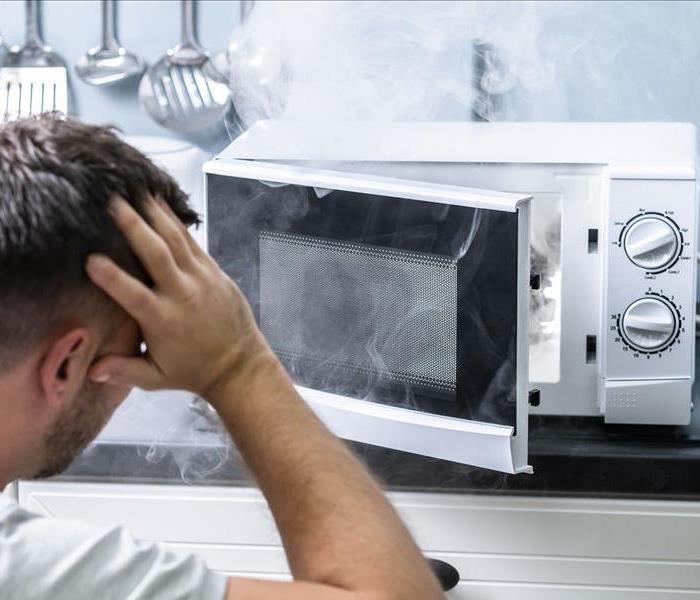Be Careful as to What You Put into Your Microwaves!
6/25/2021 (Permalink)
Over 90% of all American households use microwaves, due to their convenience via modern use of the EMS- electro-magnetic spectrum.
Our beautiful East Honolulu area is no exception from this statistic.
Microwaves also cause 4% of house-fires per year- according to the National Fire Protection Association; conversely other appliances like an oven, stove top, microwave ovens..etc compromise the other 96%.
Equally so, these appliances have numerous built-in safety features designed to minimize electrically caused fires.
Even when one sees sparks in the microwaves they are virtually harmless due to the established mechanisms.
Thus, microwaves are one of the safer appliances in one's home, although there is no guarantee they are 100% accident free.
The simplicity in which microwaves operate rests in the energy waves produced for heating up goods. These sparks are pent up energy waves -microwaves- that bounced off the aluminum walls too much. When these energy waves are generated they coagulate the water molecules resting in the food one is heating up. Consequently this is why putting certain contains, or metal causes fires; there is no water within these molecules: causing the molecules to shake until heat is generated.
Here are a few items that should never go into a microwave:
- PAPER BAGS
- TAKE OUT-CONTAINERS ESPECIALLY ONES THAT ARE CARDBOARD OR STYROFOAM
Styrofoam consists of polystyrene, a type of plastic harmful to the environment and animals alike. When heated it releases smaller chains of plastic which food and the microwave absorbs. These micro-plastics are harmful for consumption. A study came out in 2019 stating globally each person eats about 5 grams of microplastic. Partly because of the heat generated by food in these Styrofoam containers.
It is a good habit to not eat warm/heated foods in these containers all together, due to the composure of polystyrene. Only a slight 20-30 degree change from room temperature can cause the foam to break down actively while you’re still eating take-out.
- ALUMINUM FOIL/METAL GOODS
It may be easy to identify foils, but it is not so easy to recognize if there is metal in other certain household items. An example of this is paper towels, Grandmas all over East Honolulu recommend putting wet paper towels over food one is heating up. For a more even heating process, although this works to get yummy re-heated rice. There are unseen problems with paper towels themselves. Not only are they paper, thus not able to be put in the microwave in the first place; some paper towels have bits of metal woven into the sheets. It is hard to say where these metal particulates come from, but because of the consistent re-occurrence of metal in these goods it is safe to not put them in your appliance at all.
An easy replacement for paper towels are wet face towels made of cotton. Make sure to clean them before use, and designate a certain towel specifically for the microwave. Putting in towels that still have detergent on them are just as dangerous as the metal particulates found in paper towels.
Cookware with metal trimming also can be set ablaze if put into the microwave. Be very careful. Read up on your cooking utensils/pots to see if they are microwavable.
- GRAPES
Still an unknown phenomenon, grapes are very combustible for microwaves. They very easily burst and catch a flame. Scientists are still theorizing as to why, some research suggests the water content and size of grapes are the perfect size to be set ablaze.
- PLASTIC CONTAINERS
Plastic containers that say they are microwave safe generally are, but it is a good rule of thumb to not put any plastic containers into the microwave. The plastic industry is severely unregulated, many chemicals that end up inside these containers are not safe to consume. There is evidence to suggest the phytates in these plastic containers are the least scary ingredient.
- NOTHING
When there is nothing in your microwave to absorb the energy waves being produced, they continually bounce off the metal walls until a spark is created. This is the surest way of creating a fire hazard within your microwave.
Other lesser known reason for fires in microwaves consists of:
- POWER SUPPLY SHORT
Power supplies are known to burn the wiring components in the microwaves thus shorting your appliance.
- POWER SURGESS
Unregulated power surges in your microwave can also cause fires, microwaves are set up to only hold certain voltages. Too much can over power the machine lessening the safety mechanisms within the machine.
Whether it is a commercial or residential kitchen, learning your appliances- even the least fire prone- can save you money and hassle in the long run.
And if tragedy strikes, SERVPRO of East Honolulu is there to help with the restoration process. "Like it never even happened." Call us for any inquiries about damage from natural causes, or estimates at:
(808) 395-9545






 24/7 Emergency Service
24/7 Emergency Service
